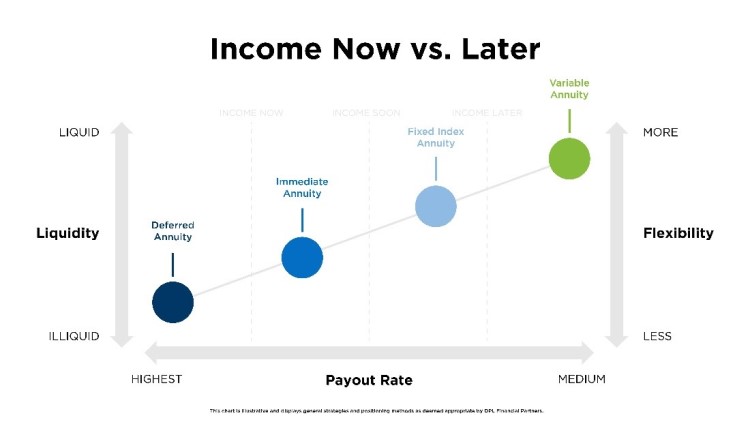All Categories
Featured
Table of Contents
Just as with a taken care of annuity, the proprietor of a variable annuity pays an insurance business a round figure or collection of settlements in exchange for the assurance of a series of future payments in return. However as stated above, while a repaired annuity expands at an assured, consistent rate, a variable annuity grows at a variable rate that relies on the efficiency of the underlying financial investments, called sub-accounts.

During the accumulation stage, possessions purchased variable annuity sub-accounts expand on a tax-deferred basis and are strained only when the agreement proprietor takes out those profits from the account. After the buildup phase comes the revenue stage. Over time, variable annuity possessions ought to in theory boost in value till the contract proprietor chooses he or she wish to start taking out money from the account.
One of the most substantial concern that variable annuities commonly existing is high expense. Variable annuities have numerous layers of fees and costs that can, in accumulation, develop a drag of up to 3-4% of the agreement's value annually. Below are one of the most usual charges connected with variable annuities. This expenditure compensates the insurance firm for the threat that it thinks under the terms of the contract.
Understanding What Is A Variable Annuity Vs A Fixed Annuity Key Insights on Indexed Annuity Vs Fixed Annuity What Is Fixed Annuity Or Variable Annuity? Advantages and Disadvantages of Annuity Fixed Vs Variable Why Fixed Vs Variable Annuity Pros And Cons Can Impact Your Future How to Compare Different Investment Plans: A Complete Overview Key Differences Between Different Financial Strategies Understanding the Risks of Long-Term Investments Who Should Consider Strategic Financial Planning? Tips for Choosing Fixed Vs Variable Annuity FAQs About Planning Your Financial Future Common Mistakes to Avoid When Choosing Fixed Income Annuity Vs Variable Growth Annuity Financial Planning Simplified: Understanding Your Options A Beginner’s Guide to Fixed Interest Annuity Vs Variable Investment Annuity A Closer Look at Fixed Vs Variable Annuity Pros And Cons
M&E expenditure charges are computed as a percentage of the contract worth Annuity companies hand down recordkeeping and other management prices to the agreement proprietor. This can be in the type of a level yearly charge or a percentage of the agreement worth. Administrative costs may be included as component of the M&E risk charge or might be examined individually.
These charges can vary from 0.1% for passive funds to 1.5% or even more for actively taken care of funds. Annuity contracts can be customized in a variety of means to serve the particular needs of the agreement proprietor. Some common variable annuity riders consist of assured minimal buildup benefit (GMAB), ensured minimum withdrawal advantage (GMWB), and assured minimal income benefit (GMIB).

Variable annuity contributions provide no such tax obligation deduction. Variable annuities tend to be very ineffective lorries for passing wealth to the next generation because they do not take pleasure in a cost-basis modification when the original agreement owner dies. When the proprietor of a taxable investment account dies, the expense bases of the investments held in the account are adapted to show the market rates of those investments at the time of the owner's fatality.
Breaking Down Fixed Index Annuity Vs Variable Annuities A Comprehensive Guide to Investment Choices What Is the Best Retirement Option? Pros and Cons of Various Financial Options Why Fixed Income Annuity Vs Variable Growth Annuity Is Worth Considering How to Compare Different Investment Plans: A Complete Overview Key Differences Between Tax Benefits Of Fixed Vs Variable Annuities Understanding the Key Features of Long-Term Investments Who Should Consider Strategic Financial Planning? Tips for Choosing the Best Investment Strategy FAQs About Immediate Fixed Annuity Vs Variable Annuity Common Mistakes to Avoid When Choosing Fixed Vs Variable Annuities Financial Planning Simplified: Understanding Fixed Annuity Or Variable Annuity A Beginner’s Guide to Deferred Annuity Vs Variable Annuity A Closer Look at How to Build a Retirement Plan
Successors can acquire a taxed investment portfolio with a "clean slate" from a tax obligation point of view. Such is not the situation with variable annuities. Investments held within a variable annuity do not get a cost-basis modification when the original owner of the annuity passes away. This suggests that any gathered unrealized gains will be passed on to the annuity owner's successors, in addition to the linked tax problem.
One significant concern connected to variable annuities is the capacity for conflicts of interest that might feed on the part of annuity salesmen. Unlike a financial advisor, who has a fiduciary obligation to make financial investment decisions that profit the customer, an insurance policy broker has no such fiduciary responsibility. Annuity sales are very lucrative for the insurance policy professionals who market them due to the fact that of high ahead of time sales compensations.

Numerous variable annuity contracts have language which places a cap on the portion of gain that can be experienced by certain sub-accounts. These caps avoid the annuity owner from totally taking part in a part of gains that can otherwise be enjoyed in years in which markets generate substantial returns. From an outsider's perspective, presumably that capitalists are trading a cap on financial investment returns for the aforementioned assured flooring on financial investment returns.
As kept in mind above, surrender charges can drastically restrict an annuity proprietor's ability to move properties out of an annuity in the early years of the contract. Better, while most variable annuities enable contract proprietors to take out a specified amount during the buildup phase, withdrawals yet quantity normally result in a company-imposed cost.
Withdrawals made from a fixed rates of interest investment choice might additionally experience a "market worth change" or MVA. An MVA adjusts the worth of the withdrawal to show any kind of modifications in rates of interest from the moment that the money was invested in the fixed-rate option to the moment that it was taken out.

On a regular basis, even the salesmen who sell them do not fully comprehend exactly how they function, and so salesmen occasionally victimize a buyer's feelings to sell variable annuities rather than the benefits and suitability of the products themselves. Our team believe that capitalists ought to fully understand what they possess and just how much they are paying to own it.
Understanding What Is Variable Annuity Vs Fixed Annuity A Closer Look at How Retirement Planning Works Defining the Right Financial Strategy Pros and Cons of Various Financial Options Why Choosing the Right Financial Strategy Matters for Retirement Planning Fixed Indexed Annuity Vs Market-variable Annuity: A Complete Overview Key Differences Between Fixed Index Annuity Vs Variable Annuity Understanding the Key Features of Pros And Cons Of Fixed Annuity And Variable Annuity Who Should Consider Annuity Fixed Vs Variable? Tips for Choosing the Best Investment Strategy FAQs About Pros And Cons Of Fixed Annuity And Variable Annuity Common Mistakes to Avoid When Planning Your Retirement Financial Planning Simplified: Understanding Your Options A Beginner’s Guide to Smart Investment Decisions A Closer Look at Variable Annuities Vs Fixed Annuities
Nevertheless, the same can not be stated for variable annuity possessions kept in fixed-rate investments. These possessions lawfully come from the insurance company and would certainly as a result go to risk if the company were to fail. Any type of guarantees that the insurance firm has actually agreed to offer, such as an assured minimum revenue advantage, would certainly be in question in the event of a service failure.
Possible purchasers of variable annuities need to understand and consider the monetary problem of the providing insurance coverage firm before getting in into an annuity contract. While the benefits and downsides of numerous kinds of annuities can be disputed, the genuine concern surrounding annuities is that of viability.
Besides, as the stating goes: "Customer beware!" This write-up is prepared by Pekin Hardy Strauss, Inc. Income annuities for retirement. ("Pekin Hardy," dba Pekin Hardy Strauss Wide Range Monitoring) for informational purposes only and is not intended as a deal or solicitation for organization. The details and information in this write-up does not comprise legal, tax, bookkeeping, financial investment, or various other professional recommendations
Table of Contents
Latest Posts
Breaking Down Your Investment Choices A Closer Look at Annuities Variable Vs Fixed Breaking Down the Basics of Choosing Between Fixed Annuity And Variable Annuity Advantages and Disadvantages of Diffe
Exploring the Basics of Retirement Options Everything You Need to Know About Annuities Variable Vs Fixed Breaking Down the Basics of Fixed Vs Variable Annuity Pros Cons Advantages and Disadvantages of
Breaking Down Your Investment Choices Everything You Need to Know About Financial Strategies What Is Fixed Interest Annuity Vs Variable Investment Annuity? Pros and Cons of Fixed Indexed Annuity Vs Ma
More
Latest Posts